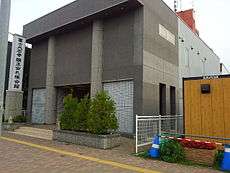Kenshōkai
Fuji Taiseki-ji Kenshōkai (冨士大石寺顕正会) is a Japanese Nichiren Buddhist religious lay group. Kenshōkai was founded as a lay group affiliated with Nichiren Shōshū in 1942 in the Myokoji Temple in Shinagawa ward in Tokyo, and was originally called Myōshinkō (妙信講). After engaging in conflict with fellow Hokkeko members, it transferred to Myoenji Temple in Sumida, Tokyo. It upholds the Taiseki-ji Head Temple to possess the true Dai Gohonzon of Nichiren, although it does not itself control Taiseki-ji. Its headquarters are located in Junō-chō, Ōmiya-ku, Saitama Prefecture.
Overview
By 1963, the explosive growth of Soka Gakkai caused Nichiren Shōshū to demand that Myōshinkō cease some proselytizing activities. In 1973, Myōshinkō resumed publishing its own newspaper and began protesting Soka Gakkai's plans to build a massive, modern-style building at Taiseki-ji, the Shōhondō. In 1974, it held a large protest against Soka Gakkai, and was subsequently excommunicated from Nichiren Shōshū due to its attempt to place a lawsuit against High Priest Nittatsu Hosoi for tolerating Soka Gakkai influence. Nichiren Shōshū now publicly state that Kenshokai is not associated with them.[1]
In 1978, Myōshinkō changed its corporate name to "Nichiren Shōshū Kenshōkai"; in 1996, the "Nichiren Shōshū" was replaced with "Fuji Taisekiji".
According to Jacqueline Stone, Kenshōkai represents the "(...) hardline Nichirenist position, promoting a rigorous Lotus exclusivism and the elimination of Dharma slander for the welfare of Japan and the world."[2] The nationalistic group[3] is considered one of the fastest-growing and least studied religious movements in Japan.[2] By its own account it has 1,370,000 members[3] most of which are in the Kantō and Chūbu areas. Unlike Soka Gakkai, it belongs to no political organization.
The Kenshokai organization uses an enlarged image of the Dai Gohonzon that was copied and transcribed by Nichikan Shonin in the year 1728, who was the 26th High Priest of Nichiren Shoshu. This image was authorized for reproduction by 60th High Priest Nichikai Shonin, who is the ancestral father of 67th High Priest Nikken Shonin. It uses the same ornamentation and scroll produced by the Head Temple Taisekiji. The present chairman of the organization is Mr. Shōei Asai, the son of Jinbē Asai, the original founder of Myoshinko.
Branch Halls
Tohoku
Kanto
Alsos
References
- Nichiren Shoshu Head Office (4 July 2006). ""Kenshokai" has no relation to "Nichiren Shoshu"".
- Stone, Jacqueline (2012). "The Sin of "Slandering the True Dharma" in Nichiren's thought". In Granoff, P E; Shinohara, Koichi (eds.). Sins and Sinners: Perspectives from Asian Religions. Brill. p. 147. ISBN 9004229469.
- Pokorny, Lukas (2011). "Neue religiöse Bewegungen in Japan heute: ein Überblick" [New Religious Movements in Japan Today: a Survey]. In Hödl, Hans Gerald; Futterknecht, Veronika (eds.). Religionen nach der Säkularisierung. Festschrift für Johann Figl zum 65. Geburtstag, Wien: LIT (PDF). p. 187.
External links
- Official Website
- Wani Yukio, Barren Senkaku Nationalism and China-Japan Conflict, The Asia-Pacific Journal: Japan Focus. This article appeared in Shukan Kinyobi on May 25, 2012.
